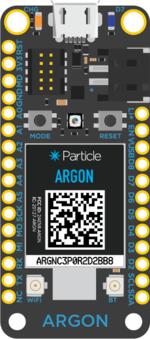Particle Argon
Overview
The Particle Argon is a Wi-Fi enabled development board with a Nordic Semiconductor nRF52840 for mesh support and an ESP32 for Wi-Fi. The board was developed by Particle Industries and has a SWD connector on it for programming.
It is equipped with a onboard LIPO circuit and conforms to the Adafruit Feather formfactor.
The Particle Argon provides support for the Nordic Semiconductor nRF52840 ARM® Cortex®-M4F SoC with an integrated 2.4 GHz transceiver supporting Bluetooth® Low Energy and IEEE® 802.15.4.
For more information about the Particle Argon board:
Hardware
On the front of the board are RGB-LED, LED and LIPO circuitry. The RGB-LED is controlled by the nRF52840 via GPIO pins.

Particle Argon (Credit: Particle Industries)
Power supply
The board is optimized for low power applications and supports two power source configurations: battery and micro USB connector.
It contains circuitry for LIPO usage and can be charged via the USB port.
Supported Features
The particle_argon board configuration supports the following hardware features:
Interface |
Controller |
Driver/Component |
|---|---|---|
NVIC |
on-chip |
nested vectored interrupt controller |
RTC |
on-chip |
system clock |
UART |
on-chip |
serial port |
I2C |
on-chip |
i2c |
SPI |
on-chip |
spi |
GPIO |
on-chip |
gpio |
FLASH |
on-chip |
flash |
RADIO |
on-chip |
Bluetooth |
Other hardware features have not been enabled yet for this board.
Connections and IOs
Please see the Argon Datasheet for header pin assignments, which are common to all Feather-compatible Particle boards. Some peripherals are available to applications through DTS overlay include directives:
mesh_feather_i2c1_twi1.dtsiexposes TWI1 on labeled Feather SDA1/SCL1 pinsmesh_feather_spi_spi1.dtsiexposes SPI1 on labeled Feather SPI pinsmesh_feather_spi_spi3.dtsiexposes SPI3 on labeled Feather SPI pinsmesh_feather_spi1_spi3.dtsiexposes SPI3 on labeled Feather SPI1 pinsmesh_feather_uart1_rtscts.dtsiadds hardware flow control to labeled Feather UART pins
LED
LED0 (blue)
LED1 (red)
LED2 (green)
LED3 (blue)
I2C
TWI0 enabled on labeled header (SDA/SCL)
TWI1 selectable with overlay (SDA1/SCL1)
SPI
SPI0 disabled due to TWI0 conflict
SPI1 selectable with overlay (SPI)
SPI2 internal to 32 Mb CFI flash chip
SPI3 selectable with overlay (SPI or SPI1)
UART
UARTE0 enabled RX/TX on labeled header (UART1); add RTS/CTS with overlay
UARTE1 internal to ESP32
Programming and Debugging
Applications for the particle_argon board configuration can be
built and flashed in the usual way (see Building an Application
and Run an Application for more details).
Flashing
Build and flash an application in the usual way, for example:
# From the root of the zephyr repository
west build -b particle_argon samples/basic/blinky
west flash
Debugging
You can debug an application in the usual way. Here is an example for the Hello World application.
# From the root of the zephyr repository
west build -b particle_argon samples/hello_world
west debug
